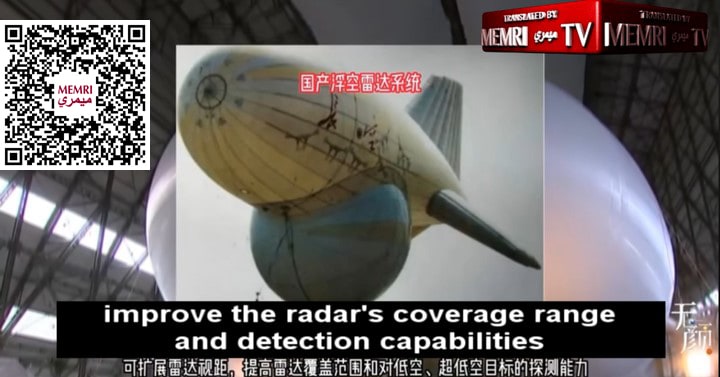
During the recent "spy balloon" incident over North America, the Chinese government claimed that the balloons were for "weather purposes." However, Chinese social media videos posted weeks prior to the incident reveal that China had been developing high-altitude airships for military and reconnaissance purposes.
The following video specifically detailed the advantages of using airships for reconnaissance, communication relay, and early warning. It emphasized that airships are difficult to detect and destroy, making them an effective tool for detecting cruise missiles and low-altitude radars. The video concluded that airships have broad military and civilian applications, which major powers are competing to acquire.
The trajectory of the "spy balloons" that the U.S. shot down closely aligns with the path outlined in this explicit military strategy. These revelations suggest that China's military was experimenting with high-altitude airships long before the "weather balloon" incident occurred.
Narrator: "On December 298, 2022, the AS700, a domestically developed manned airship named 'Xian Yun [Auspicious Cloud]' successfully completed its maiden voyage over the banks of the beautiful Zhang River, following its airworthiness certification. The Aviation Industry Special Flight Institute developed this civilian manned airship.



"Some internet users believe that China's civilian manned airship is backward technology, something that others no longer want to deal with. If that's the case, why did the mysterious flying object that appeared in the sky near the South China Sea a few days ago make the U.S. and the Philippines so nervous?
"In fact, the U.S. has always been very concerned about China's super-large airships. Several years ago, a satellite of the American Planet Labs company photographed a huge airship hangar south of Bosten Lake in Xianjiang, which, according to the American data, is over 345 meters long and can accommodate an entire nuclear-powered aircraft carrier.




"In 2019, when a tethered balloon deployed over Mischief Reef was exposed, the U.S. was deeply worried. Are airships live targets or ghosts in the air? What makes the U.S. so concerned about Chinese airships? What are the practical applications of airships? Let's delve into these questions."Military application of airships: 1. Reconnaissance: In terms of battlefield reconnaissance and surveillance, traditional methods rely heavily on satellites and unmanned aerial vehicles (UAVs).



"However, satellite reconnaissance has a long repetition cycle and cannot provide real-time continuous monitoring of the battlefield.


"Additionally, UAVs have limited flight time, making it difficult to achieve long-term ground observation. Airships, on the other hand, can be quickly deployed to the airspace near the battlefield to perform long-term, uninterrupted reconnaissance missions. Airships have low observation costs, high spatial and temporal resolution, and a wide observation range. By taking advantage of the Earth's curvature and terrain obstacles, airships can make it difficult for ground-based radars to detect them in a timely manner. Furthermore, airships have significant advantages in detecting cruise missiles and low-altitude radars, and they are not easily destroyed.


"2: Communications relay: Traditional ground-based radio systems are limited by terrain, with a limited transmission range. Satellite transmission also incurs high space loss, making it difficult to achieve small antennas and low-power transmission. This presents many difficulties for border defense communications infrastructure and emergency communication support in key areas. Airships can serve as high-altitude communication relay platforms in the battlefield, providing broadband high-speed anti-interference and ultra-long-distance communication capabilities for ground, sea, and low-altitude objects. Airships can act as relays for communication between maneuvering units on both sides of high mountains or at sea, thus expanding the effective space for combat operations.








3. Early safety warning: Airships equipped with early warning radars and optical detection devices can form an early warning and detection platform, expand the radar's line of sight, improve the radar's coverage range and detection capabilities for low-altitude and ultra-low-altitude targets. Together with satellites and early warning aircraft, they can form a comprehensive and all-weather early warning and detection system. They can detect and track various incoming targets from long distances, determine their heading, speed, and other information, and identify targets, playing an important role in air defense and missile defense operations.





"Among the various types of airships, stratospheric airships have a higher distance from the ground. In military applications, stratospheric airships can serve as a general-purpose platform with military communication, long-range reconnaissance, intelligence gathering, navigation, early warning, and other functions. They have a line-of-sight that is about twice that of an early warning aircraft, a very large detection range, and extremely high strategic value. As a result, government agencies, military research institutions, and universities in countries such as the United States, Russia, Europe, and Japan have successively launched research and development work on stratospheric airships.



"On July 27, 2011, the U.S. military and Lockheed Martin carried out the first test flight of the HALE-D stratospheric verification craft in Ohio. During the test, when the HALE-D raft rose to an altitude of about 9.75 kilometers, the exhaust valve froze, causing exhaust to fail to discharge in time. The resulting overpressure caused the hull to rupture, and the net buoyancy was insufficient, preventing the craft from continuing to rise. The test was declared a failure. Since then, there has been little public news about the development of stratospheric airships in the U.S.
"On October 13, 2015, China's first new type of near-space platform for military and civilian use, called 'Yuan Meng [Dream Come True]' successfully took off in Xilinhot, Inner Mongolia.




"It was the world's first near-space airship with continuous power, controllable flight, and reusable capabilities. The flight carried its customer's broadband communication, data relay, high-definition observation, space imaging, and air situational awareness systems, and could hover and fly within a designated range of 20 kilometers in altitude.


"In summary, airships have the characteristics of long staying-in-the-air time, strong load-bearing capacity, easy deployment, and low cost-to-efficiency ratio.


"They have important applications in the fields of reconnaissance, communication, and early warning, and are by no means outdated technologies. The development of airships has a wife range of military and civilian application needs, making them a new type of combat effectiveness that major powers are competing to seize."















